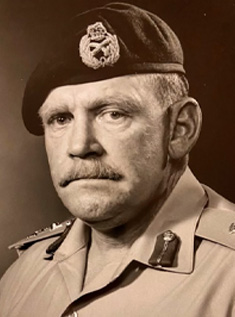
 Much has and will continue to be written about Major General Brian ‘Hori’ Howard AO MC ESM (Rtd) and his extraordinary life. Reflections on his life and service to the community will rightly highlight his operational and leadership skills.
Much has and will continue to be written about Major General Brian ‘Hori’ Howard AO MC ESM (Rtd) and his extraordinary life. Reflections on his life and service to the community will rightly highlight his operational and leadership skills.
From his early Australian Army career, of which he held a profound fondness, he made a seamless transition into the emergency management sector, firstly as Head of the Natural Disasters Organisation (the forerunner to Emergency Management Australia) then as Director of the NSW State Emergency Service and member of the NSW State Emergency Management Committee. In each of these endeavours, Hori made an enormous contribution, enhancing and improving these organisations through a balance of strategic foresight, commitment, vision and good old fashioned determination.
What’s perhaps a little less known is the contribution Hori made to the way in which relief and recovery is undertaken, both in NSW and across the country. As Head of the NSW State Emergency Service, he not only ensured the organisation’s operational capability but also recognised the importance of relief and recovery activities as well as the critical role of the not-for-profit sector working in close partnership with government to support affected communities affected. This led to the establishment of a memorandum of understanding between the NSW Government and a handful of key agencies, including the Salvation Army and Australian Red Cross, that clearly articulated the roles, responsibilities and expectations of these organisations working in partnership to support communities in need. The legacy of this partnership arrangement remains foundational in the NSW recovery arrangements to this day.
As a proud military man, Hori was aware of and committed to the importance of solid ‘doctrine’ to provide the framework and underpin good practice. To this end, he played an important part in the development of the first Australian Emergency Management Recovery Manual, released in the late 1990s. Working as the National Recovery Consultant with Emergency Management Australia at the time, I was advised that Hori would be the emergency management representative on the working group that was established to develop the manual. Hori’s somewhat intimidating reputation proceeded him and the rest of the working group weren’t sure what they were in for! What we got was an energetic and unwavering contributor, whose passion and commitment to the community challenged us to produce a critically important piece of work that had been sorely lacking.
Hori was able to draw on his vast experience on the frontline of emergencies to recognise the importance of the work, then support the expert practitioners involved in drafting chapters on topics as diverse as community-led recovery, restoration of physical infrastructure and the management of public appeals. Renowned for his steely determination and opinions, Hori was also quick to identify areas where his knowledge was lacking and was very good at seeking expertise when required. It could take a while to convince him of your credentials, but once you did, you had an extremely loyal and vocal supporter for life.
Always a great supporter of volunteers, Hori will be remembered for his work in the establishment of the Australian Emergency Management Volunteer Forum (AEMVF). Initially established in 2001, Hori was the inaugural chair and for over a decade used this platform to push for better conditions for volunteers across the emergency management sector. He was a great supporter of the diversity of organisations and volunteers that make up the fabric of the emergency management system. He was also supportive of the not-for-profit sector that he believed deserved far greater recognition and support for its critical contribution to emergency management.
A wonderful legacy of this time is the Volunteer Leadership Program, developed by AEMVF members under Hori’s leadership. From its early days, it was delivered annually at the Australian Emergency Management Institute at Mount Macedon. Today, it has grown to be one of the most important offerings under the umbrella of the Australian Institute for Disaster Resilience and occurs each year across Australia in a variety of regional settings.
Mine is just one of the many stories that emergency management colleagues will share about this talented and colourful personality who had a major role in forging the character and structure of our sector. His legacy is in the policies and practices that take a holistic view of emergency management, encourage an ‘all agencies, all hazards’ approach and put the people – both those affected by and those working in emergencies – at the centre of the picture. By continuing to collaborate and coordinate at every stage of the disaster cycle, we will be working in honour of Hori’s memory and his life work.


